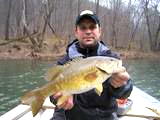EXPERIENCING THE OUTDOORS - State Buck To Doe Ratios?
 By Cory Boothe
By Cory BootheCoryboothe@hotmail.com
Dr. David Samuel, a noted professor of wildlife management and editor for numerous bowhunting magazines, suggests that our state probably has an adult doe to adult buck ratio of 6 adult does for every adult buck. Notice this is for adult deer and not fawns. Fawns are typically 1 doe fawn to 1 buck fawn. However, as hunters, we see the male fawns as does because they do not wear any headgear.
I remember hunting Calhoun County in the late 1990's and seeing 50 "does" before I would see my first "buck." In reality, out of those 51 deer, anywhere near 20 or so were males. They were just that year's fawns and only had buttons for horns. So knowing the buck to doe ratio is not as simple as it looks or sounds.
In a perfect world, its 1:1 or 2:1 does to buck ratios. Unfortunately, in most of West Virginia, we do not harvest enough does to accomplish this. West Virginia's largest problem is harvesting the majority of our antlered bucks per year. It is very much possible that we harvest up to 80% of our antlered bucks per year. With new fawn recruitment, this leads to a majority of our male herd being 1.5 years old. This is the first year they sport spike or forkhorn headgear and many die at that age. Very few males attain 2.5 or 3.5 years of age. This is an age that typically produces better antlers.
Calhoun County has a very strong deer herd but probably is not above its carrying capacity. We had many more deer per square mile ten years ago than we do now. Today's population leads to a much healthier herd. Less deer means more nutrition per deer and no browse lines in the woods.
So essentially, buck to doe ratios, age structure, and carrying capacity all play an equal role in the health of a deer herd. If you want a healthier herd in Calhoun, pass up the spike and shoot a doe, try not to shoot a button buck, and do anything in your capabilities to improve deer nutrition.